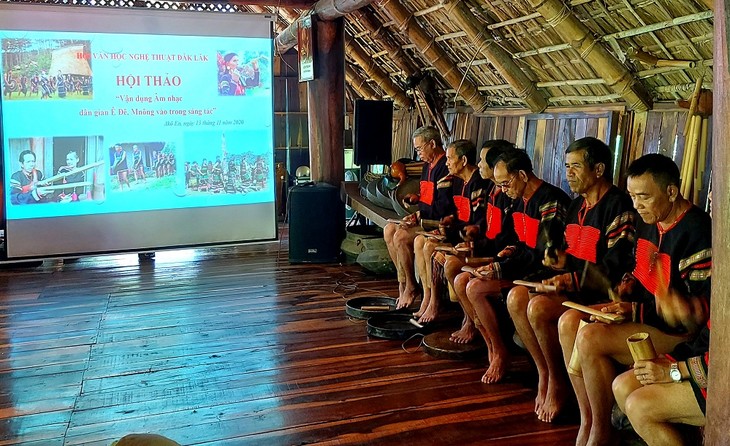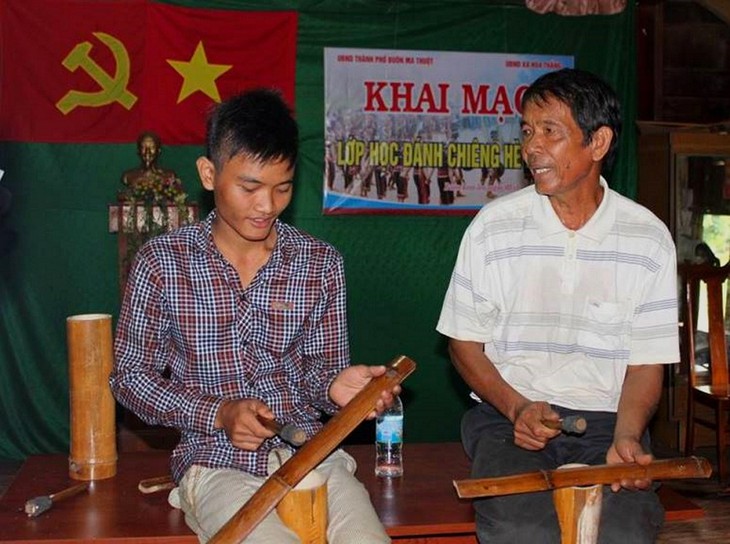(VOVWORLD) - The Central Highlands province of Dak Lak has had encouraging results after 5 years implementing a resolution of the local People’s Council on preserving and promoting its unique gong culture. Thanks to such efforts, the gong cultural space has gradually been revitalized in the local people’s daily life.
 A workshop on integrating ethnic minority folk music in music composition. (Photo: VOV) A workshop on integrating ethnic minority folk music in music composition. (Photo: VOV) |
The gong culture is an invaluable asset created by Central Highlands ethnic communities and has been constantly passed down for generations. The gong culture space spans five provinces of Kon Tum, Gia Lai, Dak Lak, Dak Nong and Lam Dong, and was recognized by UNESCO as a Masterpiece of the Oral and Intangible Heritage of Humanity in 2005.
Dak Lak’s Krong Bong district now owns 95 sets of gongs and has around 500 artists who are able to play and teach others as well as create local traditional musical instruments. It has established a communal gong club and 24 gong teams whose members are very young.
Over the past 5 years, Krong Bong has organized 12 classes training local youth in different hamlets to practice the gong. The district also organizes regular traditional musical instrument performances while reenacting ethnic peoples’ ritual ceremonies.
"Krong Bong has 8 communes with ethnic minorities. Every year we organize classes to teach the gong to young people to help them improve their performing skills and promote this unique heritage of the Central Highlands," said Pham Dinh Tan, Head of Krong Bong district’s Division of Culture and Information.
 Much attention has been paid to training gong performers at the grassroots level in the Central Highlands. (Photo: VOV) Much attention has been paid to training gong performers at the grassroots level in the Central Highlands. (Photo: VOV) |
In Krong Nang district, 14 gong teams with 500 artists and nearly 160 sets of gongs have made gong performances an indispensable part of local communities’ festivals. In addition to official training classes, gong-performing skills are also taught at home or at communal cultural practices, according to Nguyen Van Vy,Head of Krong Nang district’s Division of Culture and Information.
"There are 3 classes for students of different age groups. For students aged 15 to 20, training classes are organized at their schools. There are also evening classes at artists’ houses and at communal cultural houses for those who are busy with farm work during the day," said Vy.
Thanks to practices at the hamlets’ communal houses, the local people can learn more about their traditional culture, including dances, ritual performances and gong playing. Ngoen Nie Kdam of Krong Nang district, told VOV: "I wish that the younger generations will inherit precious traditions left by our predecessors and better promote the gong culture of the Ede ethnic group not only in the Central Highlands but also to other localities across Vietnam."
Dak Lak province has provided local ethnic artists with more than 100 gong sets and ethnic brocade costumes. Emeritus artists Vu Lan suggested that gong performances should be held more regularly in the future.
"It’s believed that group practicing brings the best results. A group should consist of 7 young performers who will be trained together and form a gong team," said Lan.
Since 2016 to 2020, 24 Dak Lak artists have been honored as "Excellent Artists" by the State President. A Central Highlands cultural gong festivals were held in Dak Lak in 2017 and Gia Lai province in 2018. Dak Lak has set a target of further promoting its gong culture across Vietnam and beyond in the next 5 years.